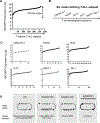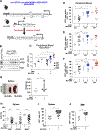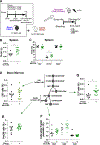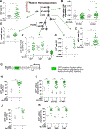Increased baseline RASGRP1 signals enhance stem cell fitness during native hematopoiesis
- PMID: 32989257
- PMCID: PMC7655557
- DOI: 10.1038/s41388-020-01469-8
Increased baseline RASGRP1 signals enhance stem cell fitness during native hematopoiesis
Abstract
Oncogenic mutations in RAS genes, like KRASG12D or NRASG12D, trap Ras in the active state and cause myeloproliferative disorder and T cell leukemia (T-ALL) when induced in the bone marrow via Mx1CRE. The RAS exchange factor RASGRP1 is frequently overexpressed in T-ALL patients. In T-ALL cell lines overexpression of RASGRP1 increases flux through the RASGTP/RasGDP cycle. Here we expanded RASGRP1 expression surveys in pediatric T-ALL and generated a RoLoRiG mouse model crossed to Mx1CRE to determine the consequences of induced RASGRP1 overexpression in primary hematopoietic cells. RASGRP1-overexpressing, GFP-positive cells outcompeted wild type cells and dominated the peripheral blood compartment over time. RASGRP1 overexpression bestows gain-of-function colony formation properties to bone marrow progenitors in medium containing limited growth factors. RASGRP1 overexpression enhances baseline mTOR-S6 signaling in the bone marrow, but not in vitro cytokine-induced signals. In agreement with these mechanistic findings, hRASGRP1-ires-EGFP enhances fitness of stem- and progenitor- cells, but only in the context of native hematopoiesis. RASGRP1 overexpression is distinct from KRASG12D or NRASG12D, does not cause acute leukemia on its own, and leukemia virus insertion frequencies predict that RASGRP1 overexpression can effectively cooperate with lesions in many other genes to cause acute T-ALL.
Conflict of interest statement
Conflict of interest disclosure
Jeroen Roose is a co-founder and scientific advisor of Seal Biosciences, Inc. and on the scientific advisory committee for the Mark Foundation for Cancer Research. C.G.M. receives research funding from Loxo Oncology, Abbvie, and Pfizer, and speaking fees from Amgen.
Figures







Similar articles
-
Investigating increased hematopoietic stem cell fitness in a novel mouse model.Small GTPases. 2022 Jan;13(1):7-13. doi: 10.1080/21541248.2021.1882832. Epub 2021 Feb 10. Small GTPases. 2022. PMID: 33517841 Free PMC article.
-
RasGRP1 overexpression in T-ALL increases basal nucleotide exchange on Ras rendering the Ras/PI3K/Akt pathway responsive to protumorigenic cytokines.Oncogene. 2016 Jul 14;35(28):3658-68. doi: 10.1038/onc.2015.431. Epub 2015 Nov 9. Oncogene. 2016. PMID: 26549032 Free PMC article.
-
Nras Q61R/+ and Kras-/- cooperate to downregulate Rasgrp1 and promote lympho-myeloid leukemia in early T-cell precursors.Blood. 2021 Jun 10;137(23):3259-3271. doi: 10.1182/blood.2020009082. Blood. 2021. PMID: 33512434 Free PMC article.
-
Expression of FLT3 receptor and response to FLT3 ligand by leukemic cells.Leukemia. 1996 Apr;10(4):588-99. Leukemia. 1996. PMID: 8618433 Review.
-
Notch Signaling in the Bone Marrow Lymphopoietic Niche.Front Immunol. 2021 Jul 28;12:723055. doi: 10.3389/fimmu.2021.723055. eCollection 2021. Front Immunol. 2021. PMID: 34394130 Free PMC article. Review.
Cited by
-
RASGRP1 targeted by H3K27me3 regulates myoblast proliferation and differentiation in mice and pigs.Acta Biochim Biophys Sin (Shanghai). 2024 Mar 25;56(3):452-461. doi: 10.3724/abbs.2024011. Acta Biochim Biophys Sin (Shanghai). 2024. PMID: 38419500 Free PMC article.
-
Phosphorylation of RasGRP1 by Shc3 prevents RasGRP1 degradation and contributes to Ras/c-Jun activation in hepatocellular carcinoma.Mol Cell Biochem. 2024 Sep;479(9):2307-2321. doi: 10.1007/s11010-023-04839-4. Epub 2023 Aug 30. Mol Cell Biochem. 2024. PMID: 37646951
-
A Focused Review of Ras Guanine Nucleotide-Releasing Protein 1 in Immune Cells and Cancer.Int J Mol Sci. 2023 Jan 13;24(2):1652. doi: 10.3390/ijms24021652. Int J Mol Sci. 2023. PMID: 36675167 Free PMC article. Review.
-
S1P-S1PR3-RAS promotes the progression of S1PR3hi TAL1+ T-cell acute lymphoblastic leukemia that can be effectively inhibited by an S1PR3 antagonist.Leukemia. 2023 Oct;37(10):1982-1993. doi: 10.1038/s41375-023-02000-0. Epub 2023 Aug 17. Leukemia. 2023. PMID: 37591940
-
Investigating increased hematopoietic stem cell fitness in a novel mouse model.Small GTPases. 2022 Jan;13(1):7-13. doi: 10.1080/21541248.2021.1882832. Epub 2021 Feb 10. Small GTPases. 2022. PMID: 33517841 Free PMC article.
References
-
- von Lintig FC, Huvar I, Law P, Diccianni MB, Yu AL & Boss GR Ras activation in normal white blood cells and childhood acute lymphoblastic leukemia. Clin Cancer Res 6, 1804–1810 (2000). - PubMed
Publication types
MeSH terms
Substances
Grants and funding
LinkOut - more resources
Full Text Sources
Medical
Molecular Biology Databases
Miscellaneous

